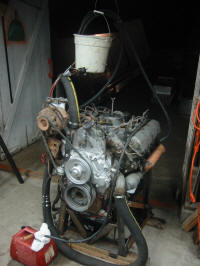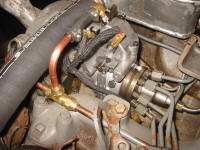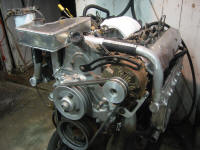|
Engine Tune-Up
(1) To test the engine a bucket was hung above to
act an an overflow reservoir for the coolant the hoses going to this
bucket are connected to coolant ports on each head. A big hose
connects the water pump to the water return. No radiator is
needed since this is only for short test. Fuel is drawn from the
small can of diesel and a return line is routed from the rear of the
fuel rail back to the can.

(1) Setup for a test run. |
|
The two batteries required for starting are under
the engine and connected in parallel. I wired a toggle switch to
the power for the glow plug controller and fuel solenoids on the
fuel pump. When the fuel pump solenoids are open they allow fuel to
be pumped to the injectors. To shut off the engine, I simply turn
off the power to the glow plug controller and the solenoids causing
the solenoids to close and cut off the fuel.
Once powered, the glow plugs are hot in about 10
seconds and then the glow plug controller will start cycling them
off and on with an audible click. There is a wait lamp circuit to
indicate when the glow plugs have done their job, but I wired a 12
volt light bulb into the glow plug circuit so I can watch when the
glow plugs have reached starting temperature and start cycling off
and on in order to maintain the temperature. Latter, I'll swap the
12 volt light bulb for and LED lamp in the cabin. Once the glow
plugs start cycling off and on I'll know I can start the engine, but
I will also be able to confirm that they stop cycling after 90
seconds as they should. Finally a momentary push button is wired to
the starter solenoid that triggers the starter motor.
Once powered, the glow plugs are hot in about 10
seconds and then the glow plug controller will start cycling them
off and on with an audible click. There is a wait lamp circuit to
indicate when the glow plugs have done their job, but I wired a 12
volt light bulb into the glow plug circuit so I can watch when the
glow plugs have reached starting temperature and start cycling off
and on in order to maintain the temperature. Latter, I'll swap the
12 volt light bulb for and LED lamp in the cabin. Once the glow
plugs start cycling off and on I'll know I can start the engine, but
I will also be able to confirm that they stop cycling after 90
seconds as they should. Finally a momentary push button is wired to
the starter solenoid that triggers the starter motor.
I also tried venting the exhaust with some aluminum
cloths dryer duct. Don't bother trying this! It took less that 3
minutes for the exhaust to burn through the duct.
(Video) After about 20 seconds of cranking to get
the fuel pumped through the system she fired up and ran! Quite
exciting without any exhaust pipes. There is still much to be
done, possible to include a complete overhaul, because she belches
smoke like there is no tomorrow.
It's time to get some compression readings on the
cylinders, see if I can get it to idle, and start reading the engine
rebuild section of the manual. I made a call today to the only
single line listing in the Yellow Pages under Engines-Diesel and
found Doug Longnecker of Diesel Power Plus. As I had hoped he is
patient with do-it-yourselfer kind of questions and very forth
coming with assistance. I'll try to put some more run time on the
engine to see how it does with fresh fuel and warm oil. Then run
some preliminary checks on compression, before letting Longnecker
test the injectors and service the pump if needed. Again the idea
here is only to get an engine for testing and then perhaps move up
to something bigger and better once all of the other bugs are worked
out. Longnecker has already suggested a 94 - 98, 370 HP Dodge
Cummings B-Series which have marine parts available.
Ran her 5 minutes tonight. After she warmed up the smoke
dissipated but did not completely clear up. She idled much
better when warm but still ran very rough at higher RPM. I
also preformed a compression test afterwards while she was still
warm. #4 is marginal at 285 psi but all of the others are 320
to 345 psi. Maybe #4 just needs a value tune up? I'll
take the injectors to be tested next. And see if they are the
source of the smoke, of if it is the timing on the injector pump.

(3) Rebuilt injector pump.
|

(4) New exhaust manifold and
coolant system parts. |
|
(3) Turns out there were 4 poorly
performing injectors, so I left them with Longnecker along with the
injector pump so he can rebuild and replace as needed. The injectors
were beyond salvage, so I now have 8 new injectors for a total of
$540.
(4) Now that the exhaust manifolds are
almost done, the pump and injectors were installed so that the final
coolant plumbing parts could be designed to warp around the fuel
pump. The fuel filter will also be relocated so that it is closer
to the block and thereby allow a smaller engine compartment.
The new coolant reservoir and lines to manifolds are
in place. I replaced the most of the pipe coming from the side of
the reservoir with a longer section of hose. This makes getting the
hose on and off a lot easier, and that is necessary in order to
adjust the fuel timing which requires you
to loosen the injector
pump and slightly rotate it. Unfortunately the three bolts holding
the pump on and they are located in spots that are bad enough
without the reservoir, coolant hose, or new fuel return line that I
crowded around the pump. While working on this I could not help to
think that I was paying for all the times I have cussed at Ford
engineers for having put some bolt in the most ungodly location.
I advanced the fuel injector timing by
rotating the top of the pump to the passenger or port side of the
engine so that the marks were about 3/16 apart. Doing this cleared
up more of the smoke while at idle and low speed, but there is
still considerable smoke at high speed. Some of this may be due to
cool running temperatures, but I don't want to take a chance on over
heating it since I don't have a complete cooling system. (Video) In the
movie of the second test I have a hand held push button along with a
12 volt light bulb wired into the glow plug circuit. You can see
the light flash on and off once the glow plugs are cycling to
maintaining their temperature, and you can hear the relay in the
glow plug control unit switching them off and on .
I have also mounted the voltage regulator
for the alternator on an aluminum bracket and connected it to the
batteries at the glow plug control unit.
The old fuel return line exits at the
rear of the engine which makes since for a truck, but I used copper
tubing and some flare fittings to route the return back toward the
front and down to the fuel lift pump. The fuel filter was then
mounted under the coolant reservoir.
|